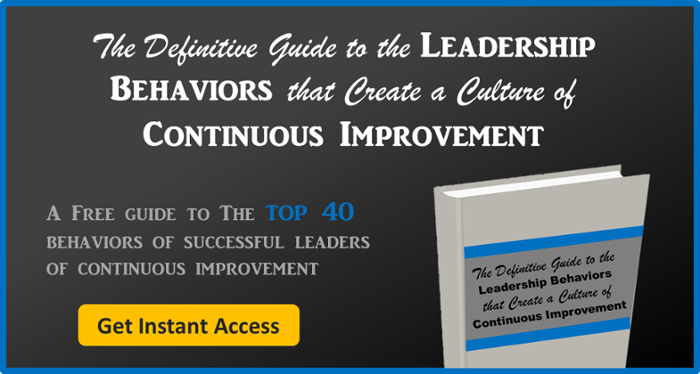 The implementation of a continuous improvement program is a difficult, never-ending process that is dependent on the level of buy-in you’re able to attain at all levels of the organization from the front lines to senior leadership. We’ve written a lot on the common pitfalls encountered when rolling out a new improvement program, many of which relate to getting staff to buy into the new philosophy and adapt their work flows to incorporate improvement. It isn’t just the staff that need to be persuaded, though; the engagement of managers is critical in getting your new improvement culture off the ground.
The implementation of a continuous improvement program is a difficult, never-ending process that is dependent on the level of buy-in you’re able to attain at all levels of the organization from the front lines to senior leadership. We’ve written a lot on the common pitfalls encountered when rolling out a new improvement program, many of which relate to getting staff to buy into the new philosophy and adapt their work flows to incorporate improvement. It isn’t just the staff that need to be persuaded, though; the engagement of managers is critical in getting your new improvement culture off the ground.
The number one thing you need to do when sharing your improvement plans with managers is to make it clear that the changes will not place an extraordinary burden on them. You know that they’re already incredibly busy with their daily tasks, and if you present continuous improvement as one more task for them to take on, you’re sure to get some push back. When they’re already swamped with managing employee duties, keeping track of supplies, and meeting with their senior leaders and employees, expecting them to implement the ideas of their employees is not a reasonable demand.
So what can you do?
You need to make it clear that the list of improvements collected in your continuous improvement software platform is not a to-do list for the managers. Your managers can not - and should not - be responsible for the actual implementation of the opportunities for improvement.
Instead, the role of managers in this new improvement culture is to coach others in implementing their own ideas. When an idea comes into the system, the manager should evaluate and respond to it as quickly as possible, which includes assigning it to somebody to work on. Typically, that person will be the person who submitted the idea in the first place, as the problem clearly affects them and they have the most invested in its successful implementation. From there, the manager is responsible for ensuring the improvement progresses on schedule, coaching the responsible person on how to implement their idea effectively, and checking to make sure an accurate impact is reported afterward.
Continuous improvement software provides features that make it easy for managers to efficiently coach others in implementing their own ideas so that the manager can have a wider reach without a greater investment of time.
Increased Visibility into All Improvements
Digital boards give managers the ability to check on the status of improvements and projects in every location, without having to travel to that location to view their local Kaizen, Huddle, or Kanban boards. In this way, managers are able to quickly identify areas and individuals who are struggling, thus maximizing the time they spend on coaching activities.
Identify Bottlenecks
Bottleneck reports are able to identify areas in which improvements are getting stuck or delayed to make it easier for managers to keep track of overdue improvement work, hone in on locations that are falling behind, and offer coaching where needed. This is the kind of information that, traditionally, managers must attend many meetings to get insight into. Continuous improvement software gives them that snapshot instantly.
Smart Notifications
Continuous improvement software also integrates smart notifications to let the right people know what has to be done and when. Completely customizable, the software sends these notifications to the team so the managers don’t have to. Managers get notifications when there’s something they need to do (like review new improvements and follow up on overdue ones) so that nothing slips through the cracks.
Overburdening managers is one way to quickly put a halt to your introduction of continuous improvement. Bringing in continuous improvement software to help them lifts this burden while promoting the principles of continuous improvement. For a great resource to pass along to your managers as they begin coaching your new improvement culture, share this free leadership eBook.



Add a Comment